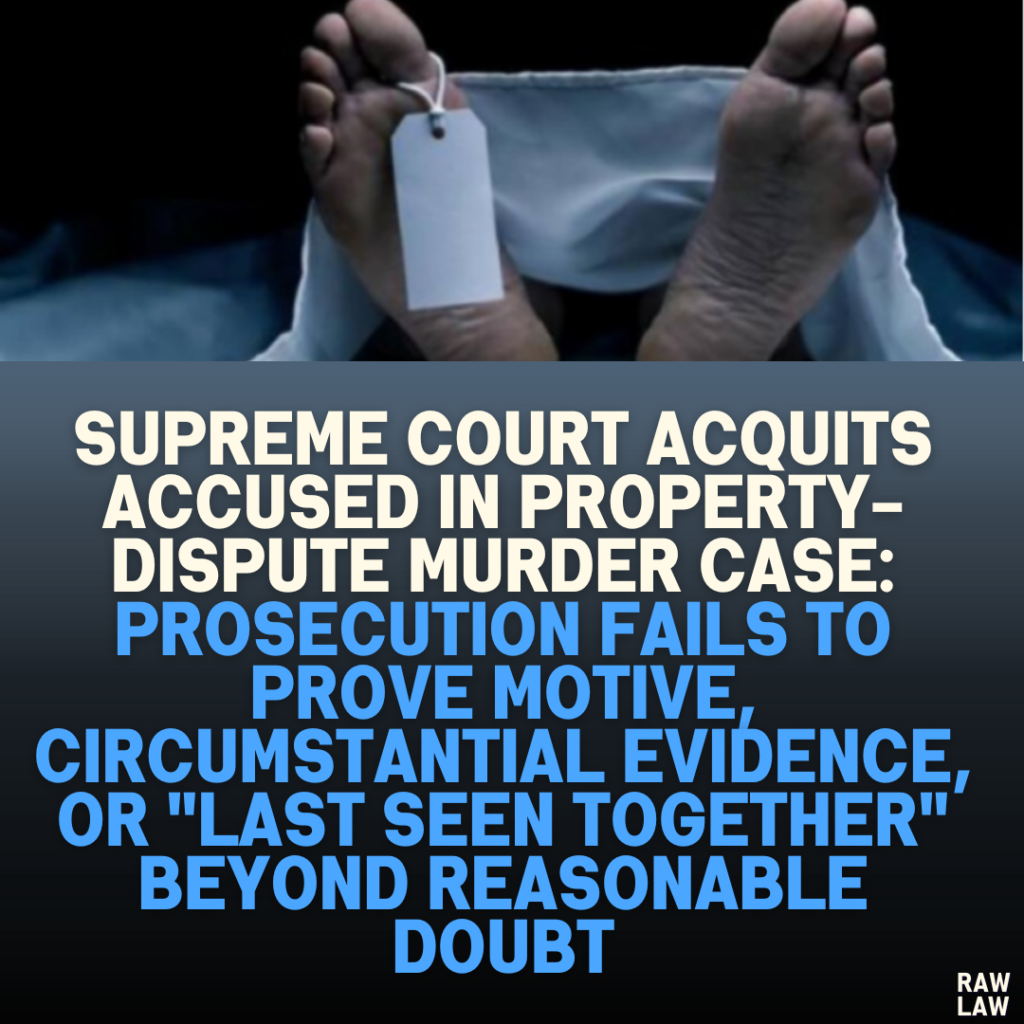Court’s Decision:
The Supreme Court reversed the convictions of Nusrat Parween, Ahmad Khan, and Abdul Rahman Khan for the alleged murder of Hamida Parween. The Court concluded that the prosecution failed to establish a complete chain of incriminating circumstances or a credible motive. Consequently, the appellants were acquitted, their bail bonds discharged, and Abdul Rahman Khan, who had not appealed, was also granted the benefit of acquittal under Article 142 of the Constitution of India.
Facts:
- Background and Property Dispute:
The deceased, Hamida Parween, resided in a property (Holding No. 13) with her three children and her in-laws after her husband’s death. The property had been partially partitioned, but disputes remained, with the accused allegedly pressuring Hamida to relinquish her share. - Incident:
On March 11, 1997, Hamida’s children found their home locked after returning from school. Hamida was later discovered dead in the house, with post-mortem findings confirming homicidal death due to asphyxia caused by strangulation. - Prosecution’s Allegations:
The prosecution alleged that the accused killed Hamida due to ongoing property disputes and attempted to cover up the crime by locking her body in the house. Charges were framed under Sections 302 and 34 of the Indian Penal Code (IPC). - Trial Court Findings:
The trial court convicted three of the accused based on circumstantial evidence, sentencing them to life imprisonment, while acquitting others for lack of evidence. - High Court Decision:
The High Court upheld the convictions of the three accused, leading to appeals before the Supreme Court.
Issues:
- Was the chain of circumstantial evidence sufficient to prove the accused’s guilt beyond reasonable doubt?
- Did the prosecution successfully establish a motive for the alleged crime?
- Could the burden of proof under Section 106 of the Indian Evidence Act be shifted to the accused based on the “last seen together” theory?
Petitioner’s Arguments:
- Failure to Prove Presence of Accused:
The prosecution failed to prove the presence of the accused at the scene of the crime or their involvement in any quarrel on the day of the incident. - Deficient Evidence for Motive:
The prosecution could not substantiate the claim of property disputes or corroborate the complaint allegedly lodged by the deceased under Sections 107 and 116(3) of the CrPC. - Weak Circumstantial Case:
The circumstantial evidence presented was incomplete and speculative. The alleged “last seen together” theory was unsubstantiated as no witnesses testified to seeing the accused with the deceased on the fateful day.
Respondent’s Arguments:
- Complete Chain of Circumstances:
The prosecution presented a chain of events indicating the accused’s guilt, including evidence of property disputes, the deceased’s injuries, and the accused fleeing after locking the house. - Medical Evidence:
The post-mortem report confirmed strangulation, corroborating the prosecution’s narrative. - Burden Under Section 106:
The accused had a duty to explain their whereabouts and the circumstances leading to Hamida’s death, as they lived in the same house.
Analysis of the Law:
1. Motive:
- Prosecution’s Claim: The accused had a motive to kill Hamida to usurp her property.
- Court’s Finding: The prosecution failed to prove motive convincingly. Testimonies of family members and neighbors indicated general disputes but provided no direct evidence of an immediate cause for murder. Additionally, the complaint filed under Sections 107 and 116(3) of the CrPC was neither produced in court nor proved.
2. “Last Seen Together” and Burden Under Section 106:
- Prosecution’s Claim: The accused were last seen with the deceased on the morning of the incident, shifting the burden under Section 106 of the Evidence Act.
- Court’s Finding: For Section 106 to apply, the prosecution must establish the accused’s presence at the scene, which it failed to do. Testimonies of neighbors and the deceased’s son did not corroborate the “last seen together” theory. The Court emphasized that the prosecution’s failure to establish foundational facts made Section 106 irrelevant.
3. Circumstantial Evidence:
- The Court reiterated that circumstantial evidence must form a complete and unbroken chain pointing exclusively to the accused’s guilt. Relying on precedents like Sharad Birdhichand Sharda v. State of Maharashtra, the Court held that the prosecution failed to meet this standard, as key links in the chain were missing.
Precedent Analysis:
- Sharad Birdhichand Sharda v. State of Maharashtra:
The five conditions for convicting based on circumstantial evidence, including conclusiveness and exclusion of alternative hypotheses, were not satisfied. - Shambu Nath Mehra v. State of Ajmer:
Section 106 does not relieve the prosecution of its primary burden to establish guilt. - Anees v. The State Govt. of NCT:
The Court highlighted that Section 106 cannot compensate for a failure to prove guilt beyond reasonable doubt.
Court’s Reasoning:
- The prosecution did not produce the complaint allegedly filed by the deceased, undermining its claim of motive.
- Witnesses, including the deceased’s children and neighbors, did not testify to the accused’s presence at the scene or any quarrel on the day of the incident.
- The failure to examine key witnesses, such as the deceased’s other children, further weakened the case.
- The prosecution’s inability to establish foundational facts rendered the “last seen together” theory and the application of Section 106 inapplicable.
- The Court criticized the prosecution for relying on conjectures and failing to provide corroborative evidence.
Conclusion:
The Supreme Court acquitted the appellants, finding that the prosecution failed to prove the charges beyond reasonable doubt. The trial court and High Court’s judgments were set aside, and the accused-appellants were granted the benefit of doubt.
Implications:
- Reinforcement of Legal Standards:
The judgment underscores the need for a complete and credible chain of circumstantial evidence in criminal cases. - Clarification on Section 106:
The ruling highlights that the burden under Section 106 arises only after the prosecution establishes foundational facts. - Caution Against Speculation:
The Court’s observations serve as a reminder that convictions must be based on solid evidence, not conjectures or assumptions.
